Charts of the Week
Charts of the week from 17 to 24 April 2023: economic sentiment, value of fiscally verified invoices, slovenian industrial producer prices and other charts
The economic sentiment deteriorated in April compared to the previous month and the same period last year, mainly due to the continued uncertain economic situation and weak foreign demand. In the first half of April, the year-on-year growth in the value of fiscally verified invoices slowed significantly, mainly due to a marked slowdown in trade. The year-on-year growth in Slovenian producer prices slowed further in March. The number of persons in employment continued to rise in February, albeit at a slightly slower pace than in previous months. The largest contribution to growth still came from the employment of foreign workers. Business sentiment indicators are suggesting that labour shortage is still a major limiting factor. The average gross wage was 1.2% higher year-on-year in real terms in February, mainly due to a significant increase in the minimum wage at the beginning of the year and a relatively low base from last year.
Economic sentiment, April 2023
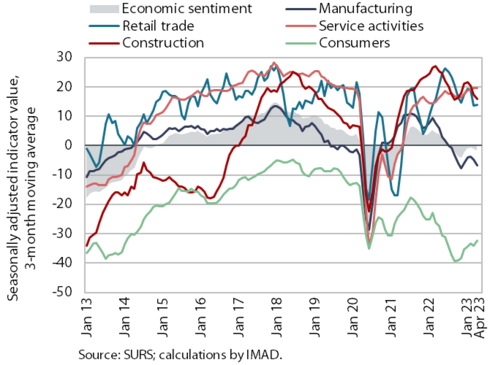
The value of the economic sentiment indicator deteriorated in April. It was 1 p.p. lower than in the previous month (seasonally adjusted). It was lower in manufacturing and services, while it was slightly higher in retail trade, among consumers and in construction. According to original data, the indicator deteriorated by 7.2 p.p. year-on-year, mainly due to lower confidence in manufacturing. All other confidence indicators also declined slightly year-on-year. This was mainly due to the uncertain economic situation and weak external demand, as export expectations declined significantly, while the indicators of overall order books, and expected and assured production in manufacturing were also lower. Labour shortage also remains an important limiting factor in industry, services and construction.
Value of fiscally verified invoices, in nominal terms, 2–15 April 2023
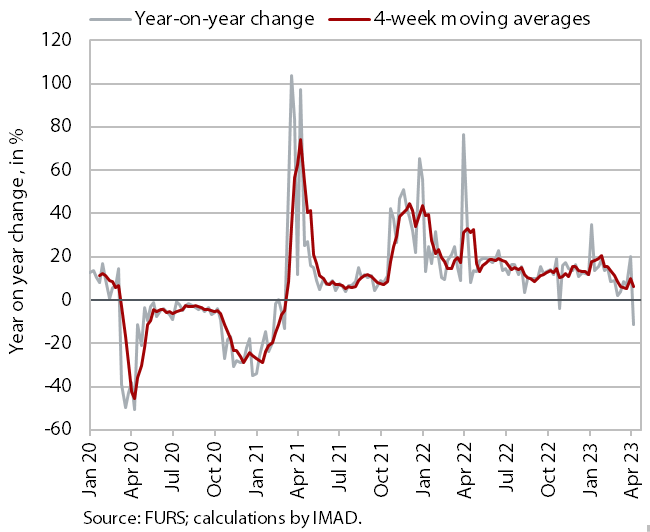
With one fewer working day this year, the nominal value of fiscally verified invoices between 2 and 15 April 2023 was 3% higher year-on-year. With one fewer working day this year (due to the timing of the public holiday), nominal year-on-year growth weakened significantly compared to the previous 14-day period. In particular, growth slowed in trade (from 8% to 3%), especially in retail trade (from 8% to 1%), which accounted for almost half of the total value of fiscally verified invoices issued. Turnover in the sale of motor vehicles increased by 15% year-on-year, while turnover in wholesale trade remained largely unchanged. Compared to the previous 14-day period, turnover growth in tourism-related services (accommodation and food service activities, gambling and betting, sports, creative and arts activities) strengthened significantly.
Slovenian industrial producer prices, March 2023
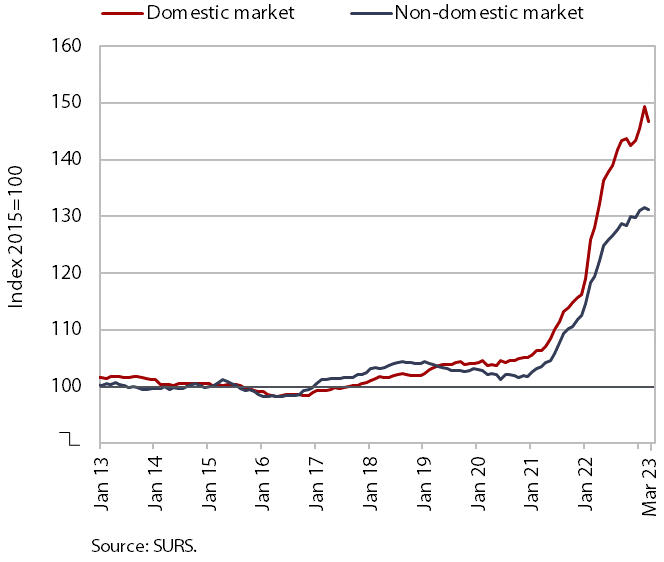
In March, Slovenian industrial producer prices remained at the same level as in the previous month, while their year-on-year weakened further to 13.4%. Growth is slowing both on the domestic (16.9%) and especially on the foreign market (9.8%). The highest year-on-year increase in industrial producer prices was again recorded in the energy group (47.7%), but there is still a large difference between growth on the domestic (53.9%) and foreign market (23.7%). Despite the slowdown in energy prices on the world markets, Slovenian energy producers’ prices rose by more than one fifth on the domestic market in the first three months of this year, while they were almost 15% lower on the foreign markets. Year-on-year price increase in the intermediate goods group has been slowing. Price growth also declined year-on-year for capital goods (8.4%) and consumer goods (13.2%).
Number of persons in employment, February 2023
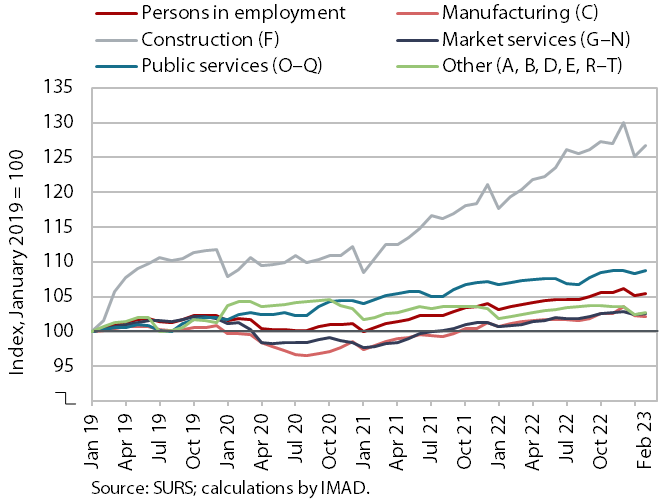
Year-on-year growth in the number of persons in employment in February was slightly lower than in previous months (1.8%). The strongest growth was seen in construction, which is facing a major labour shortage and saw the largest increase in the number of persons in employment compared to the beginning of 2019. Employment of foreign workers has been the largest contributor to the overall growth in the number of persons in employment for some time – their contribution was 81% year-on-year in February, slightly higher than in previous months. Foreigners accounted for 14.1% of total employment, up 1.3 p.p. from the previous year. The sectors with the highest share of foreigners were construction (48 %), transportation and storage (32%), and administrative and support service activities (26%).
Average gross wage per employee, February 2023
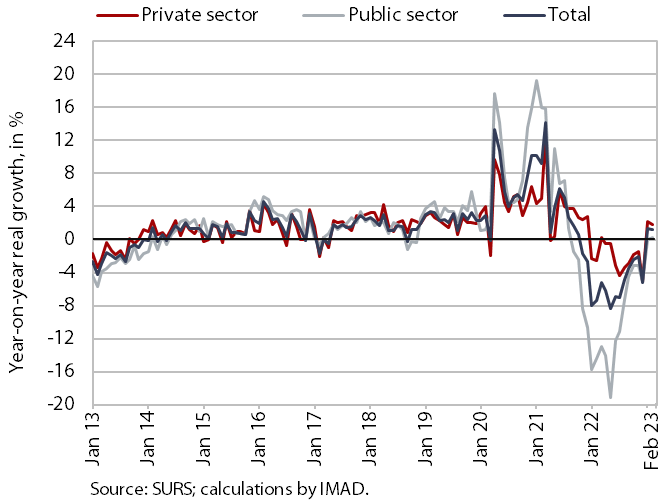
The average gross wage increased by 1.2 % year-on-year in real terms in February. This was mainly due to the sharp increase in the minimum wage at the beginning of the year and the relatively low base from February 2022. In the private sector, the average gross wage increased by 1.8% year-on-year in real terms. It was highest in administrative and support service activities and in accommodation and food service activities, which are facing a major labour shortage. Gross wage in the public sector also increased slightly year-on-year in real terms (by 0.2 %). Compared to February last year, the average gross wage increased by 10.7% in nominal terms – by 9.5% in the public sector and by 11.3% in the private sector.
